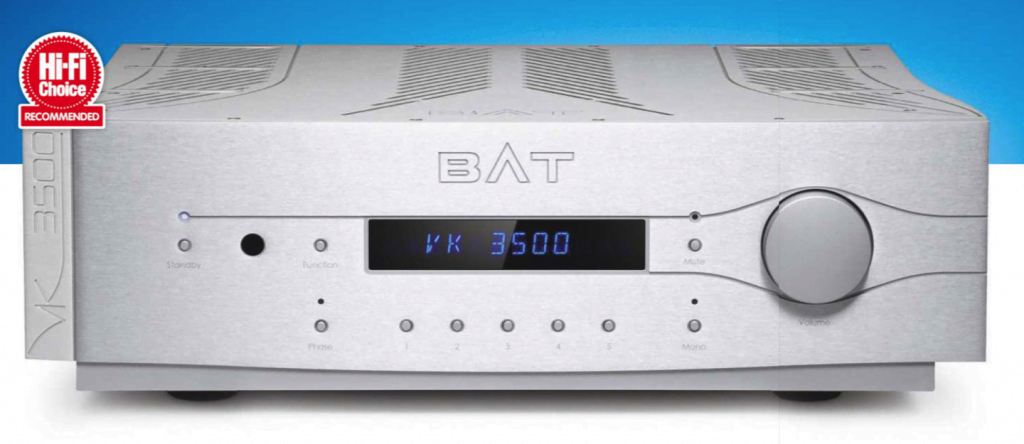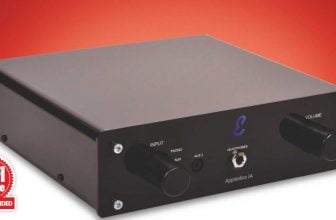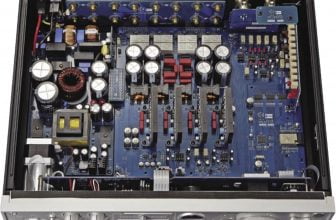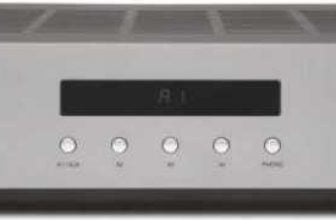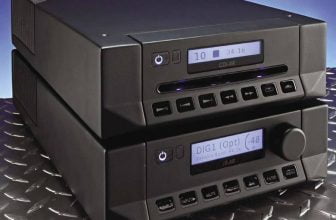Balanced Audio Technology VK-3500 Review
Boasting extraordinary power with exquisite tube finesse, BAT’s new VK-3500 integrated matches the brand’s REX 3 triode preamp with a beefy solid-state output
Even without the ‘BAT’ logo conjuring images of Gotham City’s caped crusader, the design of Balanced Audio Technology’s latest integrated amplifier has a purposeful, high-quality look and feel. There’s an argument that the appearance of a hi-fi product is unimportant, but at this price you expect some attention to detail and craftsmanship – and that’s precisely what you get. Of the silver and black finish options, the latter is the obvious choice if you really want to emphasise the Dark Knight vibe.
The amp arrived this year as part of a wave of products celebrating BAT’s 25th anniversary. The VK-3500 replaces the outgoing VK-3000SE (launched in 2014) meaning it is still the only hybrid model in the Wilmington, Delaware company’s stable. The claimed 150W into 8ohm loads power output matches BAT’s solid-state VK-255SE power amplifier, and comfortably exceeds the specification of its all-tube power amps and integrateds.
Strictly analogue
Read through BAT’s literature and you get a sense that the VK-3500 isn’t just a hybrid design, but something of a Frankenstein’s monster, comprising tried-and-trusted technologies, including the ‘zero global feedback’ appellation, from its wider range. Even the etched styling is borrowed from the flagship REX 3’s components.
BAT has called upon the ‘Unistage’ topology of its flagship REX hardware – a single-gain/single-stage 6H30 triode circuit – and married it with a ‘wide bandwidth’ complementary bipolar output stage derived from its reference VK-6200 power amp. Also previously featured in the company’s products are the Mundorf silver/gold oil capacitors used in the preamp circuit that are claimed to offer better damping of ‘ringing artefacts’.
For the VK-3500’s asking price, you might expect an integrated amplifier with a lengthy feature list and connections roster. Yet BAT isn’t a brand with an interest in all-in-one hi-fi convenience or networked audio, and the VK-3500 is a strictly analogue design. Therefore, the back view is uncluttered. Located between its sets of gold-plated speaker binding posts are two balanced XLR inputs and three single-ended RCA inputs, joined by a balanced preamp output for direct or second zone use, plus an RCA tape loop.
The only concession made to further decluttering a hi-fi rack is the inclusion of an MM/MC phono stage (designed by company co-founder Victor Khomenko) to the VK-3500’s third line input. Note that this is now fitted as standard, but was originally proposed as an optional extra – as such, the input (No5) isn’t in any way
CONNECTIONS

1 Single set 4mm speaker terminals (right channel)
2 Balanced XLR preamp outputs
3 RCA tape loop
4 2x RCA line inputs
5 2x balanced XLR inputs
6 RCA inputs to Victor Khomenko- designed MM/MC phono stage
labelled. And if you wish to switch the phono module between its high (58dB) and low (44dB) gain settings it’s a lid-off job.
In truth, BAT’s ‘simplicity without compromise’ strategy does come up a bit short when it comes to the rather in-depth setting-up of the VK-3500. Specifically, the adjustment of some feature parameters relies on using the amp’s volume control and text-based front-panel display to scroll through options and make choices. Basic tweaks can be time-consuming and one option in particular – renaming inputs – is hampered by the display’s four-character limit.
There are useful features, however, particularly the option to adjust the relative volume of individual inputs and apply maximum or fixed gain settings. There are also balance, mono/stereo operation and phase inversion controls. The blue display, which is certainly easy to read if not particularly informative, can also be dimmed if so desired.
The sound mixes crisp treble and fast bass with confident soundstaging
The VK-3500’s machined aluminium remote control is less handsome than the amplifier itself and its IR ‘window’ is quite narrow, so make sure you’re aiming it properly. Most of its controls are replicated by small buttons on the amp’s front fascia, with the exception of fade, which provides a gradual – and pleasing – level up/down alternative to mute.
The amp’s 23kg weight is perfectly manageable, but the 483mm width of its jutting face plate might possibly require reconfiguration of your kit shelf, especially if you abide by BAT’s recommendation of maintaining 6in of clearance. The amp has internal heatsinks, visible through the chassis sides, and these do a good job of keeping everything cool.
Sound quality
The VK-3500’s power output is obviously well up to scratch and paired with Bowers & Wilkins 705 S2 standmount, there is an effortless feeling to how it cajoles it along, making the speaker sound large, exciting and sprightly. Paradigm’s triple-woofer Founder 100F floorstander ostensibly presents more of a challenge, but again this amplifier doesn’t seem especially bothered, driving the loudspeakers without so much of a hint of strain.
Overall, the VK-3500’s sound mixes crisp, sparky treble and fast, precise bass with a deliciously dynamic delivery and confident, detailed soundstaging. It gives a mostly transparent view of recordings without descending into clinical indifference while treble is typically more wholegrain mustard than buttery smooth. It’s certainly an attention-grabbing performance.
It Never Rains from Dire Straits’ enormo-selling Love Over Gold, begins with a major key keyboard melody, gentle percussion and floating guitar licks, but ends with an extended instrumental section where Pick Withers’ drumming gains intensity, Mark Knopfler lets his bluesy guitar notes fly and a phase effect threatens to render it a sonic soup. BAT’s VK-3500 artfully handles both, approaching the introduction with a light touch but matching the drive and dynamics later on beat for beat, while keeping the elements distinct.
INSIGHT

1 A single PSU transformer feeds a ‘dual-mono’ layout…
2 …with separate left/right rectification and regulation
3 Preamp stage uses one Electro- harmonix6H30P double-triode per channel
4 Power amp stage has four pairs of ON Semiconductor transistors per side
5 Phono/RIAA board plugs in via an edge connector at the rear of the case
Last year the company celebrated its 25th anniversary with the release of third-generation models of its flagship REX hardware, including the REX 3 digital-to analogue converter. Its plan was to launch the VK-3500 (as well as updates on its 80 and 90 series components) at the same time, but this was halted due to the coronavirus pandemic. Explains Steve Bednarski: “The pandemic delayed the launch of this second wave… Something as simple as working face to face with our mechanical and industrial designers became difficult during the past year. Everyone stayed safe and the new models are now here.” Buyers are therefore assured that the VK-3500 shares the 25th Anniversary Design circuitry brought to the REX flagships – just a year later than originally intended.
Queen’s Death On Two Legs, the vicious opening track from the band’s fourth LP – 1975’s Roy Thomas Baker-produced A Night At The Opera – has a characteristically everything- but-the-kitchen-sink production befitting an album reported at the time to be the most painstaking and expensive ever recorded. It was reputed to be about a former manager and resulted in a defamation lawsuit so you can say without fear of exaggeration that it’s not an easy ride.
Needless to say though, the BAT VK-3500 never, er, bats an eyelid and appears not even slightly baffled. Each note of Freddie Mercury’s piano intro sounds cleanly struck, and then, as if snapping its fingers, the VK-3500 launches into the guitar riff, bringing bite and edge to Brian May’s tone. Musical flourishes sparkle left and right while the drums sound weighty and intense from start to finish.
A particularly notable trait of the VK-3500 is the fun it has with deep bass. Low-end transients come and go like momentary explosions, as exemplified by the one-note bassline progressions in Eminem’s extremely naughty My Name Is off the master rapper Marshall Mathers’ second album, The Slim Shady LP Mostly produced with typical pizzazz by Dr Dre, this is a track that the BAT really gets itself into and it also has something of a ball when playing with the bouncy kick drums of Regina Spektor’s Fidelity, the opening track on the Soviet-born American
The VK-3500 sounds extremely detailed, speedy, alive and rhythmic
singer-songwriter’s fourth LI’ Begin To Hope. In both instances the listening experience takes on a physical dimension. The latter track’s title proves apt here, too, as the amplifier relishes Spektods lilting, articulate vocal and the plucked string accompaniment, expressing them with enjoyable verve and quite remarkable clarity.
So the VK-3500 sounds detailed and alive, speedy and rhythmic. If it does have a weakness, though, it may just be that some might prefer more warmth to its presentation and a softer edge to its upper registers – a weekend filled with high-volume listening to the likes of Aerosmith, The Rolling Stones and AC/DC does throw up the occasional shrill moment. Never enough, however, to be seriously detrimental to the continuous enjoyment of these gnarly old rock and roll dinosaurs stomping their stuff, such is the vim, growl and snarl that this stunning amplifier is able to bring to the party.
Conclusion
When introduced to more tonally nuanced material, the VK-3500 completely cherishes the three- dimensional soundstaging and textured trumpet of the title track from German jazzer Nils Walker’s 2012 LP Just Here, Just Now and when fed some modern, techy electronica (and even with a regular-sized standmount), the impression is that it wouldn’t be out of place doing front-end duty in a nightclub. Paul Oakenfold’s Save The Last Trance For Me taken from his second LI’ 2006’s A Lively Mind comes straight out the gate at full-throttle, a pounding drum track underneath waves of reverberant synths. Yet this slab of euphoria is peppered with surprisingly delicate touches, such as an isolated high-pitch woodblock that echoes serenely right-of-centre.
And with a track where the lower frequencies are less prominent, the integrated is able to shift gear just as effortlessly. Through the big Paradigm Founder 100F loudspeaker, the sustained organ notes, soft strings and falsetto vocals of a 24-bit/88.2kHz stream of Pause, by multi-instrumental outfit Emily Barker & The Red Clay Halo, are painted in varying subtle shades. The recording sounding utterly spine-tingling throughout
